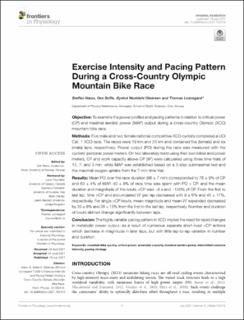| dc.contributor.author | Næss, Steffan | |
| dc.contributor.author | Sollie, Ove | |
| dc.contributor.author | Gløersen, Øyvind Nøstdahl | |
| dc.contributor.author | Losnegard, Thomas | |
| dc.date.accessioned | 2021-11-08T15:27:30Z | |
| dc.date.available | 2021-11-08T15:27:30Z | |
| dc.date.created | 2021-08-25T09:46:38Z | |
| dc.date.issued | 2021 | |
| dc.identifier.citation | Frontiers in Physiology. 2021, 12(2021), Artikkel 702415. | en_US |
| dc.identifier.issn | 1664-042X | |
| dc.identifier.uri | https://hdl.handle.net/11250/2828441 | |
| dc.description | This is an open-access article distributed under the terms of the Creative Commons Attribution License (CC BY). The use, distribution or reproduction in other forums is permitted, provided the original author(s) and the copyright owner(s) are credited and that the original publication in this journal is cited, in accordance with accepted academic practice. No use, distribution or reproduction is permitted which does not comply with these terms. | en_US |
| dc.description.abstract | Objective: To examine the power profiles and pacing patterns in relation to critical power (CP) and maximal aerobic power (MAP) output during a cross-country Olympic (XCO) mountain bike race.
Methods: Five male and two female national competitive XCO cyclists completed a UCI Cat. 1 XCO race. The races were 19 km and 23 km and contained five (female) and six (male) laps, respectively. Power output (PO) during the race was measured with the cyclists’ personal power meters. On two laboratory tests using their own bikes and power meters, CP and work capacity above CP (W') were calculated using three time trials of 12, 7, and 3 min, while MAP was established based on a 3-step submaximal test and the maximal oxygen uptake from the 7-min time trial.
Results: Mean PO over the race duration (96 ± 7 min) corresponded to 76 ± 9% of CP and 63 ± 4% of MAP. 40 ± 8% of race time was spent with PO > CP, and the mean duration and magnitude of the bouts >CP was ~8 s and ~120% of CP. From the first to last lap, time >CP and accumulated W' per lap decreased with 9 ± 6% and 45 ± 17%, respectively. For single >CP bouts, mean magnitude and mean W' expended decreased by 25 ± 8% and 38 ± 15% from the first to the last lap, respectively. Number and duration of bouts did not change significantly between laps.
Conclusion: The highly variable pacing pattern in XCO implies the need for rapid changes in metabolic power output, as a result of numerous separate short-lived >CP actions which decrease in magnitude in later laps, but with little lap-to-lap variation in number and duration. | en_US |
| dc.language.iso | eng | en_US |
| dc.subject | anaerobic capacity | en_US |
| dc.subject | critical power | en_US |
| dc.subject | intermittent exercise intensity | en_US |
| dc.subject | maximal aerobic power | en_US |
| dc.subject | mountain bike cycling | en_US |
| dc.subject | pacing strategy | en_US |
| dc.title | Exercise intensity and pacing pattern during a cross-country Olympic mountain bike race | en_US |
| dc.type | Peer reviewed | en_US |
| dc.type | Journal article | en_US |
| dc.description.version | publishedVersion | en_US |
| dc.rights.holder | © 2021 Næss, Sollie, Gløersen and Losnegard | en_US |
| dc.source.pagenumber | 10 | en_US |
| dc.source.volume | 12 | en_US |
| dc.source.journal | Frontiers in Physiology | en_US |
| dc.identifier.doi | 10.3389/fphys.2021.702415 | |
| dc.identifier.cristin | 1928569 | |
| dc.description.localcode | Institutt for fysisk prestasjonsevne / Department of Physical Performance | en_US |
| dc.source.articlenumber | Artikkel 702415 | en_US |
| cristin.ispublished | true | |
| cristin.fulltext | original | |
| cristin.qualitycode | 1 | |
